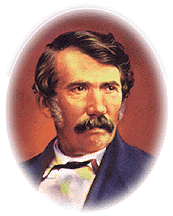 Livingstone was a curious combination of missionary, doctor, explorer,
scientist and anti-slavery activist. He spent 30 years in Africa,
exploring almost a third of the continent, from its southern tip almost to
the equator. He was the first white man to see Victoria Falls.
Livingstone was a curious combination of missionary, doctor, explorer,
scientist and anti-slavery activist. He spent 30 years in Africa,
exploring almost a third of the continent, from its southern tip almost to
the equator. He was the first white man to see Victoria Falls.
Livingstone was born on March 13, 1813, in Blantyre, Scotland, where he spent the first twenty-three years of his life. His parents, devout Christians, played an important role in his life by introducing him to the subject of missions. As a young man, he worked in a local mill, but refused any thought of this becoming his destiny. By the time he turned twenty-one, Livingstone had accepted Christ and made up his mind to become a medical missionary. He heard of Robert Moffat, a missionary to South Africa, tell of the work going on in Kuruman. Within eighteen months, he saved enough money to continue his education. After completing medical school, he accepted a position with the London Missionary Society in South Africa. And on December 8, 1840, he set sail for Kuruman. A year later, he was granted permission to move 700 miles into the African interior to establish another missionary station. Livingstone wasted no time setting things up at Mabotsa. In 1845, he returned to Kuruman where he met and married Robert Moffat's daughter, Mary. Livingstone often took Mary and four children with him while crossing the African wilderness. Still, there were many times when they could not be together. Livingstone completed one of the most amazing journeys ever undertaken - a coast to coast venture that covered four thousand miles of unexplored land, most of which was located along the Zambezi River. After an extended visit to England, Livingstone and his wife began their last journey and most famous journey together in 1865. It was during this adventure that Livingstone faced the severest trial of his life; Mary died in 1862 from complications related to African fever. Sorrow and discouragement plagued Livingstone. After several failed attempts to set up mission stations in the interior and along the coast, Livingstone concluded God was leading him in another direction. No European had ever ventured into North Africa. This would be his next goal and his greatest accomplishment for future missionary work. "I am a missionary, heart and soul," wrote Livingstone. "God had an only Son, and He was a missionary and a physician. A poor, poor imitation of Him I am, or wish to be. In this service I hope to live; in it I wish to die." No other person has done more to further mission efforts than David Livingstone. Marching inland in 1866, Livingstone reached Lake Nyasson on August 8 and began journeying north toward Lake Tanganyika. He wrote: "O Jesus, grant me resignation to Thy will, and entire reliance on Thy powerful hand . . . The cause is Thine. What an impulse will be given to the idea that Africa is not open if I perish now! . . ." Livingstone was often weakened by bouts of African fever. Months rolled by and then years without the outside world knowing where he was. On Nov. 10, 1871 in the village of Ujiji, on the east side of Lake Tanganyika, Livingstone encountered Henry Stanley, who had been sent by the New York Herald Tribune newspaper to find and help him. With Stanley's supplies Livingstone continued his explorations, but he was weak, worn out and suffering from dysentery. Then, on the morning of April 30, 1872, his two African assistants found him kneeling at his bedside, dead. They dried his body and carried it and his papers on a dangerous 11-month journey to Zanzibar, a trip of 1,000 miles. The natives buried his heart in Africa as he had requested, but his body was returned to England and buried in Westminster Abbey. <information from http://scotlandvacations.com/livingstone.htm, http://www.intouch.org/myintouch/mighty/portraits/david_livingstone_213698.html> |